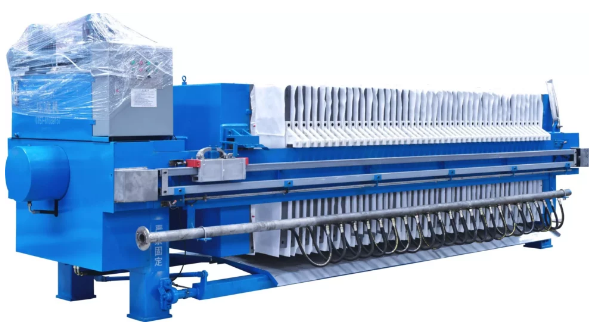Other parameters include filter cake thickness, maximum feed pressure at which the slurry is fed to the press, and filter cloth selection. The filter cake built on the cloths does the majority of the solid/liquid separation. Some fines may pass through the cloth at first, but the solids eventually form a layer on the filter cloth, similar to a pre-coat. While filter presses are excellent pieces of dewatering equipment, they work best with a slurry that contains about percent solids. Lowering the solids concentration requires first passing the water through a clarifier. If the flow rate is constant, the pressure-time relationship can be calculated.
What Is Filter Press?
Each plate has filter media that determines which particles are dewatered and separated from the liquid. A filter press is a batch operation, fixed volume machine that uses pressure filtration to separate liquids and solids. It is used for water and wastewater treatment in a wide range of applications, from industrial to municipal. While different types of filter presses work differently, they all follow the same principles.
Other technologies have minimum requirements for optimal solids dewatering and will not work unless enough feed is available. Open or closed filtrate discharge – An open filtrate discharge makes it easier to identify damaged filter cloths. Filter media is available for any application and/or operating condition, as with all ErtelAlsop presses, and is selected based on your specific operating conditions. ErtelAlsop provides the most diverse selection of filter media and construction techniques to ensure good particle retention, clear filtrate, high flow rates, and dry filter cakes. Filter cloths are available in a variety of materials, including polypropylene, polyester, cotton, and other synthetic materials. The cloths are made of monofilament, multifilament, or spun fibers.

J-Press® Plate Shifters are designed to provide effective cake removal. After the initial fill, an AOD pump capable of delivering 0.1 gallons per minute per square foot of surface area should be selected for presses 125 cubic feet and less. The 5% Aluminum Hydroxide slurry, on the other hand, may take 4-6 hours to dewater, whereas the 10% slurry will dewater in 2-3 hours. The driptray launder or plate discharge port is used to discharge the effluent. Remove contaminants such as dirt, loam, clay, and other harmful materials from aggregate feedstock. Separate light, harmful material while classifying, sorting, and washing sand and other granular materials.
Press Operation
However, increasing the feed pressure to the press would be preferable to save wear and tear on the AOD feed pump and extend the useful life of the filter cloths. The double Air Operated Diaphragm pump is ideal for filter press operations with press capacities of 125 cubic feet or less. As solids accumulate within the press, the flow resistance increases and the flow rate through the press decreases. At a given air pressure supply, the time between pump strokes for an AOD pump gradually increases while causing no harm to the pump.
Using an AODD pump eliminates the need to power the press, which simplifies operation, reduces installation costs, and increases safety. They can be controlled via pressure regulation, making installation and operation simple. As a result, the pump that processes the fluid must be stopped on a regular basis so that the filters can be cleaned. This eliminates the need for a settling pond or tailings pond while also reusing process water. Instead of being covered with tailings, valuable land reserves can be protected or freed up by eliminating the need for tailings ponds or settling ponds.
Filter presses are now widely used in a variety of industries, and they generate a variety of wastes. Harmful wastes, such as toxic chemicals from dye industries and pathogens from the waste stream, may accumulate in waste cakes, necessitating a different approach to waste treatment.
